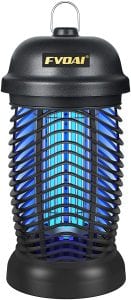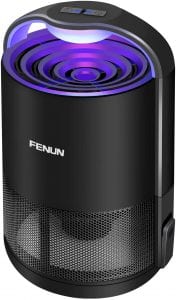The Best Mosquito Traps

Our Review Process
Don't Waste Your Money is focused on helping you make the best purchasing decision. Our team of experts spends hundreds of hours analyzing, testing, and researching products so you don't have to. Learn more.
Our Picks For The Top Mosquito Traps
If mosquitoes and gnats are a problem in your area, consider setting up one of these bug zappers. The device works to attract the insects with a 15-watt light, but then zaps them with electricity when they land on the grid. Just one of these bug zappers can cover an area as wide as 2,100 square feet.
EPA RegisteredYou can use this mosquito trap both indoors and outdoors.
Not a fan of zapper insect lanterns? Go with this mosquito trap instead. It uses a UV light to attract insects and then vacuums them in once they get close to the upper opening. The bottom sticky trap captures the bugs, so they don't get back out.
Choice of ColorsThis mosquito trap is available in a choice of black or white.
The 4,200 volt grid on this mosquito trap is so powerful it will sometimes eliminate a flying insect with no debris to clutter the easy-clean trap. A waterproof hard plastic frame and safety cage prevents humans or pets from touching the grid while also allowing the trap to operate rain or shine.
Indoor/Outdoor and WaterproofPowerful enough for the great outdoors and safe enough to use indoors, this is an all-purpose trap for a variety of flying insects.
This is a powerful electric mosquito trap that can attract and eliminate mosquitoes, fruit flies and gnats. It has an effective range of 80 meters, or 860 square feet. The easy-to-remove bottom can be emptied with minimal fuss, and the weatherproof design means it’s suitable to leave up year-round.
Weatherproof and CleanableLightweight and affordable, this trap will be a great option to get rid of flying insects in a limited area.
Buying Guide
Mosquito traps come in a variety of sizes and types, from traditional electric grid “zapper” models to silent traps that use light, chemicals, heat or other lures to draw insects away from humans. Many mosquito traps also work on other pests, such as gnats or flies.
A popular type of trap uses hyacinthine light to attract mosquitoes. Hyacinthine light is a very specific range of wavelength (365 to 395 nanometers) within the ultraviolet range (100 to 400 nanometers), named for resembling the hyacinth flower’s natural color.
Mosquitoes primarily see in the wavelength of 395 nanometers (nm), so a trap using this light will result in a more efficient and targeted mosquito trap. If you select a trap that uses an electrical grid to kill insects, it’s recommended to get one with at least 4,000 volts to completely kill any insect it attracts.
Mosquito traps operate best at roughly 7 feet off the ground to ensure they are out of reach of children and still within range of low-flying insects.
What to Look For
- If you have pets or children, make sure to look for safety features on traps so that they can’t touch any electrical elements or chemicals used in the trap.
- Health codes for professional kitchens state that insect-trapping devices should be located away from food storage and preparation areas so that insect debris does not get into food. Even if you’re not running a professional kitchen, this is still a consideration when placing traps.
- Place the trap roughly 30 feet away from the area you plan to sit to draw pests away from you.
More to Explore
With the huge number of mosquito traps on the market and how much demand there is for them, it may be surprising to hear that backyard mosquito trap technology has a long way to go to catch up with industrial models.
According to the American Mosquito Control Association, some places have used dry-ice baited traps to catch upwards of 65,000 mosquitoes per night. However, these traps are often not safe to use in residential areas and need to be deployed carefully in order to not lure more mosquitoes into a region than they kill.
















